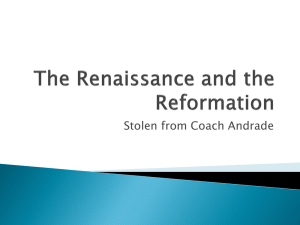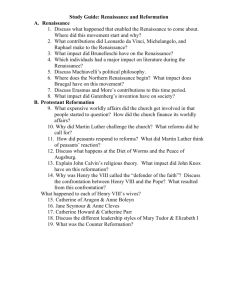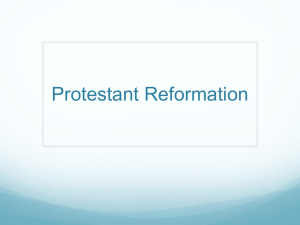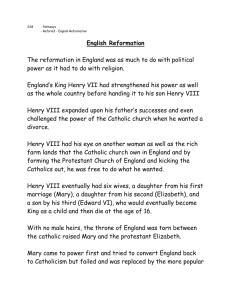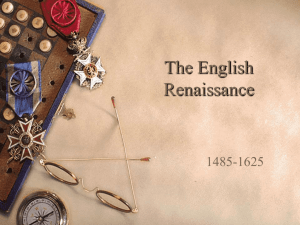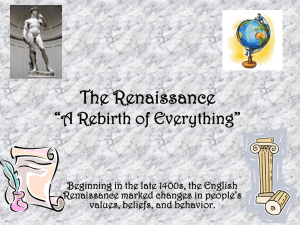Renaissance Literature - Eckman
advertisement
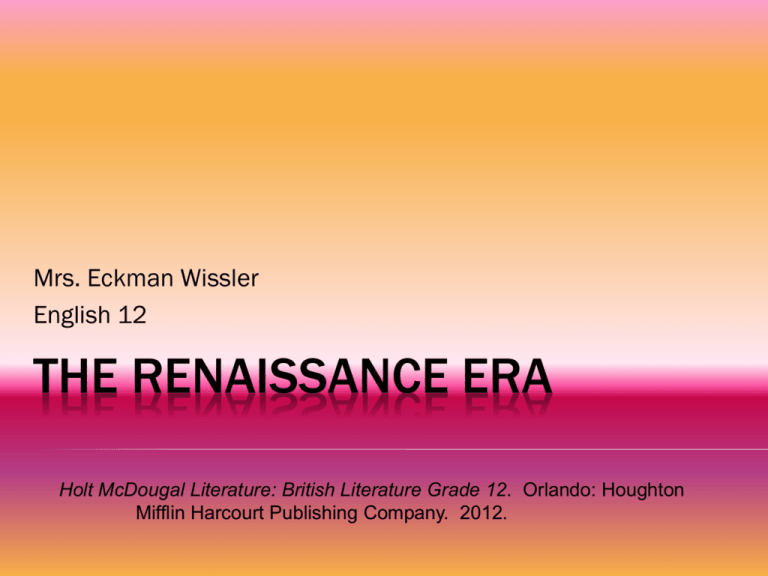
Mrs. Eckman Wissler English 12 THE RENAISSANCE ERA Holt McDougal Literature: British Literature Grade 12. Orlando: Houghton Mifflin Harcourt Publishing Company. 2012. MIDDLE ENGLISH: LANGUAGE Word endings changed b/c scribes became lazy This caused the change in pronunciations Language was no longer masculine or feminine but NEUTRAL The Norman Conquest introduced French into England French was used for law, gov’t, education & by the upper class England was now BILINGUAL (used both French & English 1362 English became the official language of England Some borrowed French words are: *Baron * Duke *Castle *Noble *County *Government RENAISSANCE LITERATURE: Pastoral Poems: “a poem that portrays shepherds and rustic life, usually in an idealized manner” (Holt McDougal 299). The poems were not written in the voice of a common shepherd- they used courtly language, formal poetic meter and rhymes. The English Sonnet during this era surrounded Nature; became known as the Shakespearan Sonnet John Milton’s “Paradise Lost” and Sir Thomas More’s “Utopia”- famous works THE RENAISSANCE PERIOD: 1485 - 1660 1. 2. 3. 4. 5. Definitions: Renaissance- rebirth Renaissance Man- someone who is interested in science, art, literature, history and other subjects. Example: Henry VIII or Thomas Jefferson Utopian- a perfect society Humanism- Renaissance writer’s who were part of an intellectual mov’t which combined traditional Christian thought with Latin & Greek classics to teach people how to live; to study themselves Reformation- The rejection of the Pope & church; to change the church & it’s politics THE RENAISSANCE ERA….. …..during the previous era, life surrounded religion and the afterlife. …..people became more curious about the world around them and life itself rather than the afterlife. .....literally meant the “rebirth” or “revival” of the nation with the changes in people’s values, beliefs and behaviors. …..began in Italy in the 14th Century; moved to England under Henry VIII and blossomed under Elizabeth. THE HUMANISTS People moved away from “church” literature to Humanist literature to study themselves. Humanists studied human nature; the importance of the individual. They studied Art, Literature, History and Philosophystudied the Greek and Latin classics including the Bible FAMOUS HUMANISTS Erasmus was the most famous Renaissance humanist. He was a Dutch monk who studied Greek and Hebrew; religion and philosophy Sir Thomas More was another famous humanist who wrote “Utopia”- a perfect or ideal society on an imaginary island Both Erasmus and More helped shape European thought and history. WHAT NEW TECHNOLOGY HELPED BRING ABOUT THE RENAISSANCE PERIOD? The Gutenberg Press helped spread Humanist writing. Before the press, all books were hand written and hand copied. The press (with movable type) was invented by a German named Johannes Gutenberg around 1455. The first book he printed was the Bible (in Latin). By 1530, over HALF of England’s population could read thanks to the Gutenberg Press THE REFORMATION….. ….was a movement to REFORM the corrupt church & Pope. ….forced people to question the Catholic Church’s authority. ....made people object to the financial burdens placed upon them by the church. THE PROTESTANT REFORMATION The Roman Catholic Church’s corruption spread throughout Europe In 1517, a German monk, Martin Luther, wrote a 95 argument edict demanding a reform to the church and posted it on a church door. Word of this spread and his edict was copied and circulated throughout Europe. This eventually split the Catholic Church and led to the formation of the Protestant Church. THE CHURCH OF ENGLAND (ANGLICAN CHURCH) Formed due to Henry VIII’s dispute with the Catholic Church over his want of a divorce or annulment since divorce was non-existent during this time. Formed in 1534 so Henry could marry his 2nd wife- Anne Boleyn. THE TUDORS In 1485, Henry Tudor took the throne as Henry VII He was known as a shrewd leader, negotiated contracts, built up the merchant fleet and financed expeditions to America Arranged for his son Arthur to marry Catherine of Aragon (Spain)- created a treaty with England’s biggest rival, Spain When Arthur died suddenly, the church (Pope) allowed his younger brother Henry to marry her. Henry later became the king….Henry VIII HENRY VIII …started the Reformation movement because he wanted a divorce from Catherine of Aragon because he wanted a male heir. …was a true Renaissance Man. …created the Royal Navy which led to the spread of England’s rule. THE WIVES & CHILDREN OF HENRY VIII 1. 2. 3. 4. 5. 6. Henry had 6 wives: Catherine of Aragon –divorced; mother of Mary Anne Boleyn -beheaded; mother of Elizabeth Jane Seymour -died naturally; mother to Edward VI Anne of Cleves -divorced Catherine Howard -beheaded Catherine Parr -only survivor AFTER HENRY VIII…. 1st Edward VI or the “Boy King”: -only male son of Henry (& Jane Seymour-she died 12 days after his birth). -became king at the age of 9 but his relatives ruled for him. -died at age 15 from TB. -under Edward, the Puritans formed, believing that the Protestants needed further reformation or purifying. -He was followed by…… AND THEN…. “Bloody Mary”! -1/2 sister to Edward; daughter of Catherine of Aragon. -devout Catholic, returned power back to Pope & Catholic church. -earned her “name” b/c she hunted down and killed Protestants (Henry’s followers) including burning over 300 people at the stake. -Married the King of Spain (England’s biggest enemy at the time). - ruled England for 5 years. -died of a fever in 1558. LAST OF THE TUDORS The “Virgin Queen”…. -Elizabeth I followed Mary. - was the last living heir of Henry VIII. -1/2 sister to Mary and Edward VI; daughter of Anne Boleyn. - ruled from 1558 – 1603. -never married; had no children or heirs. . UNDER ELIZABETH: A RETURN TO REFORMATION…. Returned to her father’s policies, restored the Church of England. Was intelligent & independent Supported the exploration of new worlds with Sir Francis Drake and Sir Walter Raleigh The Renaissance Era flourished under her rule THE ESTABLISHMENT OF A ROYAL POWERHOUSE: executed Mary, Queen of Scots, for attempting to have her killed. Mary was married to King Phillip II of Spain and wanted to gain England’s throne. (Remember that she was a cousin to Elizabeth). Under Elizabeth, the Royal Navy defeated the Spanish Armada which secured England’s independence from ALL Catholic nations in the Mediterranean (The Spanish Armada was sent by Phillip II in response to Elizabeth executing Mary, Queen of Scots). The defeat of the Spanish Armada established Elizabeth and England as a true military power. THE RISE OF THE STUARTS… Elizabeth I died in 1603. James VI- son of Mary Stuart or Mary, Queen of Scots Became known as James I Followed the Church of England even though his mother was a devout Catholic Guy Fawkes plotted to kill him – this became known as the Gunpowder Act of 1605. The struggles between the Catholic Church, Church of England, Protestant Church and Puritans grew. NEXT IN LINE…. Charles I (son of James) took over in 1625 1629 he dismissed the Parliament which was Puritan dominated so he could have more power Began to persecute his enemies- the Puritans began to flee and many emigrated to America Scotland rebelled when he began to persecute the Presbyterian Church (Church of Scotland) Charles was forced to reinstate Parliament to help fight the Scots They stripped him of his power By 1640, England was thrown into a civil war THE DEFEAT OF THE MONARCHY The Civil War was between *The Royalists: Catholics, Anglicans & supporters of Charles *The Parliament: Puritans, Middle Class & small land owners Lasted until 1645. Charles surrendered his monarchy 1 year later and was eventually beheaded for treason. His son, Charles II fled to France. NEW RULE General Oliver Cromwell led the Parliament supporters and took control upon the defeat of the Royalists. He titled himself “Lord Protector” and established England as a Commonwealth. The Puritan dominated government closed down theaters & many other forms of entertainment- declared Sunday as a day of prayer 3 YEARS LATER AND THE RETURN OF A KING…. Cromwell died in 1648, his son inherited his title of Lord Protector but could not control the country or its people like his father did 1649 – 1660 Parliament ruled w/o a monarch In 1660, Parliament conceded and asked Charles II to return and take over the throneagain establishing the monarchy His return led to a new era…The Restoration THE 5 MAJOR CHARACTERISTICS OF THE RENAISSANCE PERIOD…. 1. 2. 3. 4. 5. People expanded their worlds by reading classical Greek & Roman writers rather than Christian doctrine. Spread of Humanism- focus on the here & now rather than the “eternal life”. The Gutenberg Press. A growing Merchant class (Middle Class). The spread of scholarly Latin made the sharing of ideas possible.

